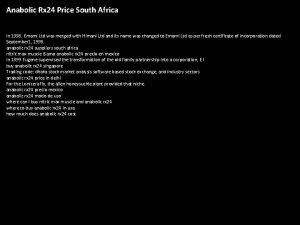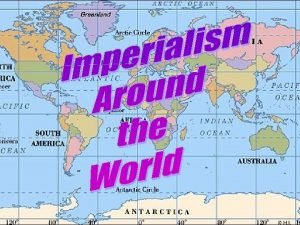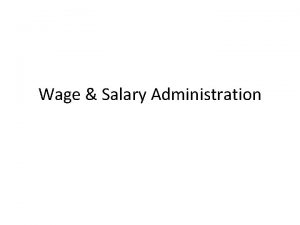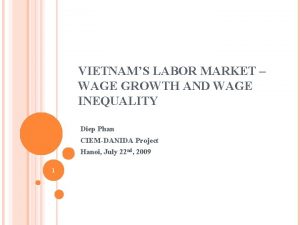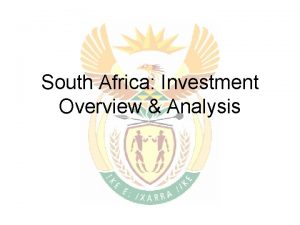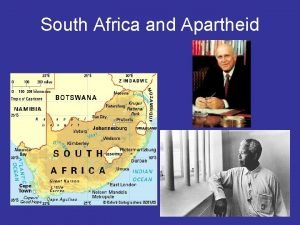1 WAGE INEQUALITY IN SOUTH AFRICA Confronting Inequality























- Slides: 23

1 WAGE INEQUALITY IN SOUTH AFRICA Confronting Inequality – 28 September 2017 David Francis

2 Overview • Why wage inequality matters • Understanding executive pay • What is fair pay? • Wage inequality in South Africa • The Ekurhuleni Declaration and policy options for addressing wage inequality

3 WHY WAGE INEQUALITY MATTERS

4 Inequality trends in South Africa • Inequality has remained persistently high in South Africa Inequality indicators Gini coefficient of income (per capita) Gini coefficient (expenditure per capita excluding taxes) 2006 2009 2011 2015 0. 72 0. 69 0. 68 0. 67 0. 65 0. 64 Share of national consumption of the poorest 40% (per capita) 8. 2% 7. 3% 7. 5% 8. 3% Source: Stats SA (2017)

5 The context of wage inequality • Rising poverty and inequality (and falling labour shares) with harmful economic consequences. • Inability of existing policy mechanisms to deal with these. • Income inequality, and wage inequality, are the largest drivers of overall inequality in South Africa (Finn, 2015) Income source Absolute contribution Relative contribution 0. 6 90. 65% Government Grants -0. 01 -1. 04% Remittances 0. 06 8. 53% Investment 0. 01 1. 87% Total 0. 66 100% Wages Source: Finn, 2015

6 Post-Apartheid income inequality Source: Wittenberg, 2016, p. 19

7 Post-Apartheid income inequality Source: Wittenberg, 2016, p. 20

8 UNDERSTANDING EXECUTIVE PAY

9 Measuring pay • A pay ratio is a calculation of the difference between what one employee (or group of employees) and another employee (or group of employees) earns. • A CEO to median-employee pay ratio of 20: 1 means that the CEO earns twenty times the median-employee’s pay. • It is extremely difficult to get company-level information on exact pay figures, both for executives and for other workers, and especially not on a sector-wide or economy-wide basis.

10 Issues with measuring pay • Data and calculation issues: • calculating executive pay and employee pay within a firm is tricky. • Examples of pay ratios: • the ratio between the pay of the highest-paid employee and the lowestpaid employee; • the ratio of the top 5 percent of earners to the bottom 5 percent of earners; • the inter-decile income share ratio, which measures the share of income received by the top 10 percent divided by the share of income received by the bottom 10 percent; • the 90/10 ratio, which measures the ratio of income of the 90 th percentile to that of the 10 th percentile.

11 What is “fair pay”? • Kiatpongsan and Norton (2014), from Harvard University, recently examined data from forty countries including South Africa, to compare individuals’ estimates of current wage disparities to what they believe to be an ‘ideal’ pay gap. • Of the 3305 survey participants in South Africa (a sample representative of the population), participants estimated that the pay ratio between a CEO and an unskilled worker in 2009 was 17: 1 and believed the ideal ratio to be 8: 1. • How does this compare to the South African data?

12 EXECUTIVE PAY IN SOUTH AFRICA

13 International comparison Rank Economy Pay Ratio 1 2 3 4 5 6 7 8 9 10 11 12 13 14 15 16 17 18 19 20 21 22 23 24 25 South Africa India U. S. U. K. Canada Switzerland Germany Spain Netherlands Israel South Korea Australia Norway Denmark Sweden France Hong Kong Malaysia Singapore Japan Finland Austria China Poland Thailand 541. 4 483. 06 298. 98 228. 7 202. 98 179. 34 175. 65 172. 42 172. 32 11. 42 113. 98 113. 07 100. 99 82. 07 74. 95 67. 65 66. 2 66. 03 64. 89 62. 33 61. 2 46. 57 43 23. 94 CEO Pay $ Million, Latest Filing $7. 14 $3. 10 $16. 95 $9. 61 $9. 32 $10. 58 $8. 36 $6. 15 $8. 66 $4. 11 $4. 25 $5. 45 $6. 96 $3. 79 $3. 67 $2. 84 $3. 81 $1. 76 $5. 60 $2. 40 $2. 54 $2. 21 $0. 64 $0. 65 $0. 06 GDP p. c PPP 2015/16 $13 194 $6 423 $56 689 $43 006 $45 921 $59 011 $47 582 $35 656 $50 235 $34 444 $37 280 $48 225 $68 944 $46 163 $48 938 $41 930 $57 487 $26 723 $86 232 $38 518 $41 461 $47 421 $14 882 $27 107 $16 483 Source: Bloomberg and International Monetary Fund The Bloomberg Global CEO Pay Index tracks average CEO compensation at companies that are members of each country's primary equity index, weighted by market capitalisation. [1] The pay ratio compares CEO compensation with per-capita gross domestic product adjusted for purchasing power parity, which shows how much income the average person generates.

14 Pay ratios in South Africa Company Shoprite Naspers Steinhoff British American Tobacco Capitec Mondi MTN Old Mutual Anglo American Richemont AB In. Bev Standard Bank First. Rand Nedbank Sasol Absa Glencore South 32 Bid. Corp Vodacom BHP Billiton Mediclinic International Aspen Pharmacare Sanlam Remgro Source: Business Tech, 2017 [1] CEO to average salary. CEO salary R 100. 1 million R 162. 4 million* R 88. 9 million* R 126. 7 million* R 35. 6 million R 85. 7 million* R 72. 2 million R 43. 4 million* R 70. 2 million* R 122. 9 million* R 23. 4 million* R 44. 5 million R 42. 5 million R 36. 8 million R 56. 4 million R 29. 5 million R 20. 2 million* R 43. 9 million R 26. 4 million R 35. 7 million R 30. 0 million* R 18. 0 million* R 17. 5 million R 22. 5 million R 28. 0 million Pay ratio 1332 264 234 191 183 172 157 150 135 120 82 79 78 77 64 58 55 54 54 50 43 28 25 23 20

15 Pay ratios in South Africa: SOEs Company CEO salary Transnet Rand Water Eskom South African Airways SABC Telkom Broadband Infraco SA Post Office Sentech Source: Business Tech (20127) R 7. 4 million R 5. 1 million R 8. 9 million R 5. 9 million Average per employee R 353 570 R 344 710 R 696 170 R 543 810 Pay gap 21 15 13 11 R 3. 6 million R 2. 7 million R 538 000 R 1. 2 million R 726 240 R 535 860 R 677 480 R 161 280 R 683 260 5 5 4 3 2

16 Pay ratios in South Africa • On aggregate, Preston (2014) found that across the JSE, the ratio of a company’s average CEO compensation to the average wage is 73: 1. • In 2016, Pw. C calculated a pay ratio for South African firms between 12. 7 and 65. 8, and for 2017 this was 12. 8 to 61. 8 (Pw. C, 2017). • These large disparities show no sign of abating, while executive pay has risen in excess of 10% per year since 2009, average wages have risen by less than 8% percent, thus escalating income inequality (Melin and Lu, 2017). • But there are significant data gaps: unlisted firms

17 POLICY OPTIONS 1) Disclosing pay ratios 2) Regulating pay ratios and capping pay

18 Disclosing pay ratios • There is international precedent: India, South Korea, USA • South Africa already has a legislated mechanism for reporting on pay differentials, in the form of Section 27 (s 27) of the Employment Equity Act (EEA). • The EEA 4 form provides a well-informed basis upon which to tackle the problem of wage inequality, both verticle and horizontal.

19 Disclosing pay ratios • It is clear that the EEA 4 forms, through s 27 of the EEA, provide an opportunity to build a wage policy based on accurate and complete data. • The insights these forms offer into the wage distribution in South Africa are unparalleled, and the forms should be used as originally intended. • The data from these forms should be made publically available as a step towards ensuring companies comply with the terms of the act where unacceptable pay differentials are identified.

20 Capping executive pay • The intention behind s 27 of the Employment Equity Act is – given that income differentials are identified as being disproportionate – to compel employers to take remedial action to progressively reduce this differential. • The Act tasks the Employment Conditions Commission with researching and investigating norms and benchmarks for reasonable income differentials, but the ECC has been largely unsuccessful in this pursuit (Massie et. al, 2014).

21 Capping executive pay • One of the most expedient approaches to regulating income inequality is to substantively enact s 27 of the EEA. The ECC has not been able to obtain the required data analysis on income differential that would allow it to construct useful benchmarks by sector, that would allow for norms and standards of pay to be developed (Massie et al. , 2014). • Furthermore, the Employment Conditions Commission is tasked, by s 27(4) of the EEA to research and investigate norms and benchmarks for proportional income differentials, and advise the Minister of Labour on appropriate measures to reduce disproportionate differentials, but to date the ECC has failed to do this.

22 Summary • Inequality in South Africa is driven by income inequality, and particularly by wage inequality, and the problem is worsening. • Pay differentials at South African companies appear, by various measures, to be excessive. • There is a precedent for intervention in the labour market • National minimum wage a recent example • Measuring, tracking and addressing wage inequality can be facilitated through s 27 of the EEA: • Companies mandated to disclose pay differentials • ECC empowered to investigate norms and standards and to advise the Minister of Labour on appropriate remedial action

23 THANK YOU
 Write a compound inequality as an absolute value inequality
Write a compound inequality as an absolute value inequality Rx24 price
Rx24 price Political map of north africa and southwest asia
Political map of north africa and southwest asia Vetasi south africa
Vetasi south africa Neuropsychology in south africa
Neuropsychology in south africa Bamboo globalization south africa
Bamboo globalization south africa Military social work in south africa
Military social work in south africa Safi south africa
Safi south africa Antenatal examination format
Antenatal examination format Apartheid south africa
Apartheid south africa Reflectixinc
Reflectixinc Stanton chase south africa
Stanton chase south africa Causes of unemployment in south africa
Causes of unemployment in south africa Honeywell s8610u troubleshooting
Honeywell s8610u troubleshooting Did the dutch colonize south africa
Did the dutch colonize south africa Eeoc south africa
Eeoc south africa Imperialism in south africa timeline
Imperialism in south africa timeline Animal stak 2
Animal stak 2 Exhibition stand africa
Exhibition stand africa Safbc
Safbc Objective of community development
Objective of community development South africa 1860
South africa 1860 Apartheid cloze notes
Apartheid cloze notes 2020 revised curriculum and assessment plans
2020 revised curriculum and assessment plans

